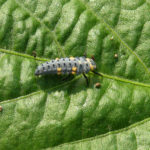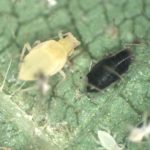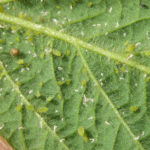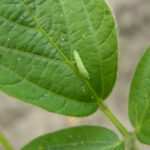
This is a ladybeetle larvae. They can be black or a dull grey/purple with orange or yellow markings. If they are shaped like an alligator, they are a ladybeetle larvae. It will be an adult ladybeetle soon. Both the larvae and adults feed on aphids.

The black velvet coloured aphid on the right is a parasitized soybean aphid. It is dead because a tiny wasp has laid its egg inside the aphid and the young wasp has eaten the aphid from the inside. The adult wasp will emerge from the aphid soon to parasitize other aphids.

The white flakes in this picture are cast skins of the aphid. They are NOT dead aphids. Aphids need to shed their skin to grow so they leave behind what looks like dandriff on the plants. Do not use these to count or determine if the aphids are reaching threshold or are dying. Only count the aphids that are Mountain Dew coloured.

This is a syrphid fly larvae. It is also a natural enemy. It is a blind maggot that crawls around the leaf until it bumps into an aphid and then eats it.
These are just some examples of the natural enemies that may be busy at work in your fields. For more information on these and soybean aphid management, here is a link to the Canadian Soybean Aphid Scouting Cards: http://www.soybean.on.ca/aphidinfo/uploads/soybean_aphid_scouting_card__english.pdf
🙂
We will be spraying for aphids near Kincardine along lake huron asap when it dries up a little.